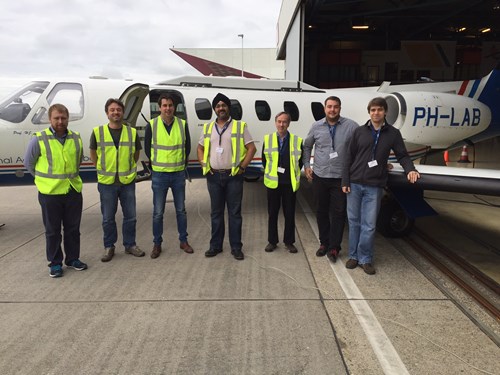Inmarsat and European Space Agency complete first test flights for air traffic modernisation project
Iris Precursor programme aims to significantly optimise European airspace capacity, leading to overall reductions in flight times, fuel burn and CO2 emissions
Inmarsat (ISAT.L), the world’s leading provider of global mobile satellite communications, has successfully completed the first flight trials for Iris Precursor, a ground-breaking project to enhance and modernise air traffic management over European airspace.
Iris Precursor focuses on the development and deployment of secure satellite-based data link communications to significantly optimise European airspace capacity, leading to overall reductions in flight times, fuel burn and CO2 emissions. Iris Precursor aims to complement existing terrestrial data link communications (VDL2), which are expected to reach capacity in the near future.
Inmarsat is conducting the Iris Precursor programme with a consortium of leading companies from across the air traffic management, air transport, aeronautics and satcom industries, under the European Space Agency (ESA) umbrella. The programme, which is supported by ESA’s programme of Advanced Research in Telecommunications Systems (ARTES), will deliver services via Inmarsat’s secure next-generation SwiftBroadband-Safety platform.
Four test flights were conducted from Amsterdam under an initial phase to validate the use of satellite-based data link for secure communications and surveillance applications, and compare the capabilities to existing terrestrial data link communications. They were operated on aircraft from the Netherlands Aerospace Centre (NLR) using a prototype of the Iris terminal developed by Honeywell and connected to Inmarsat’s next-generation SwiftBroadband-Safety service through Inmarsat’s aviation partner, SITA, the world's leading air transport IT and communications specialist.
Each of the flights travelled in different routes, covering all directions to ensure connectivity was maintained as the aircraft crossed satellite beams. The end-to-end connection between the aircraft and SITA’s Controller Pilot Data Link Communication (CPDLC) test ground system was tested extensively and allowed air traffic control messages to be exchanged using Aeronautical Telecommunications Network and Security gateways.
While the Iris Precursor programme will initially focus on continental Europe, it will also benefit air traffic management in other regions around the world in the longer term.
Captain Mary McMillan, Inmarsat’s Vice President of Aviation Safety and Operational Services, said: “Efficiency improvements are fundamental to aviation modernisation programs in Europe. As air traffic volume continues to increase, the digitisation of the cockpit is one of the ways to alleviate current congestion on traditional radio frequencies and optimise European airspace, one of the busiest in the world. Using the power and security of satellite connectivity through Iris clearly changes the game in comparison to the ground technology in use today.
“The successful completion of these flight trials brings Iris Precursor an important step closer to initial operational capability, which is currently targeted for 2019. It demonstrates that the use of satellite technology for dense continental airspace is not only a long-term solution, but also a reliable system in the short-term to solve air traffic management issues today.”
Magali Vaissiere, Director of Telecommunications and Integrated Applications at ESA, said: “ESA’s Iris programme is forging ahead as part of Europe's long-term goal to modernise air traffic control. A stepped approach and good collaboration between public and private partners is bringing excellent results.”
The flight trials complement a separate test flight that Airbus conducted with Inmarsat and other partners in March this year, as part of the Single European Sky ATM Research (SESAR) programme, which successfully performed initial 4-dimensional/4D flight path control and CPDLC exchanges between aircraft and air traffic control.
Inmarsat is now working toward a second phase of flight trials for Iris at the end of next year. At this point, Iris technology will be considered fully validated. The next phases of the programme include pre-operational validation by flying Iris technology on commercial flights in a real air traffic management environment. The Iris Initial Operational Capability will go live as early as 2019, complementing terrestrial systems and bringing enhanced security, safety and efficiency.

Team members from Inmarsat, the European Space Agency (ESA) and Honeywell during recent test flights for the Iris Precursor air traffic modernisation project.


.png)





.jpg)
Comments
There are no comments yet for this item
Join the discussion